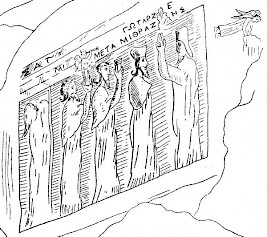Arsaces XI, Mithradates II
Arsaces XI, Mithradates II: Arsacid king of the Parthian Empire (r.121-91).

In 122 BCE, Mithradates' father, king Artabanus, had been killed in action during a battle against the Yuezhi nomads. At the same time, Charax in southern Babylonia had revolted and the rebels had even captured Babylon. The first successor of Artabanus, Arsaces X, could not consolidate his power and was soon replaced - we do not know how - by Artabanus' son Mithradates.
He managed to restore order, first on the northeastern frontier, where he defeated the nomads. Almost immediately after, he opened the Silk Road to China.
Now, he moved to Babylonia, where he suppressed the insurrection. He also captured Dura Europos on the Euphrates: a bulwark that could protect Babylonia against attacks from Syria. Having secured the empire in all directions, he attacked king Artavasdes I of Armenia, accepting hostages (including the future king Tigranes). Later, he added Edessa, and concluded a treaty with the Roman commander Sulla: the river Euphrates would be the border between the two empires.
Cuneiform documents like the Euphrates Chronicle (BCHP 20) document projects to stimulate the economy: in this particular case, a canal was created to make trade easier. The imperial administration was restructured, although the claim by modern scholars that the scribes switched to parchment and papyrus, so that cuneiform writing now came to an end, is incorrect. (The youngest clay tablet we can date is from 77 CE.)
During the last years of his reign, there were domestic problems. His relative Sinatruces revolted in Elam and it was left to Mithradates' son Gotarzes to suppress the insurrection. Mithradates died in 91 BCE after a reign of thirty years. His death marks the beginning of a brief "dark period" in Parthian history.
Note
The chronology of the Arsacid kings of the Parthian Empire is less well-understood than, for example, the sequence of Seleucid and Ptolemaic kings or the emperors of Rome. This information is based on the researches by G.R.F. Assar, as published in "Iran under the Arsakids, 247 BC – AD 224/227" in: Numismatic Art of Persia (2011).